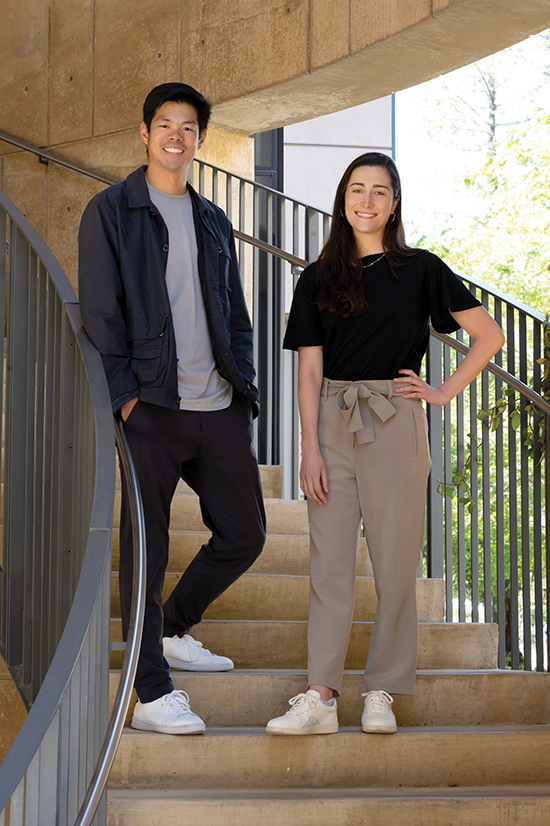Harvesting Climate Benefits From Agriculture and Forestry Practices
Take a moment and picture the greatest sources of greenhouse gases that contribute to climate change. Some readers might envision a plume of smoke rising from a power plant. Others may reflect on emissions from airplanes or gas-powered vehicles. But pollution from farmland or food systems? Probably not. The vision of climate change that captures public discourse is one that too often focuses exclusively on energy production for powering societies, rather than the caloric energy production needed for feeding people.

and Katelyn McEvoy, JD/MS ’23
Food systems, at their best, should nourish us, preserve cultural traditions, and strengthen communities. Farmers have long been the backbone of American society, combining tradition with cutting-edge research and development. Our farmlands and rangelands cover nearly 900 million acres, nearly 40 percent of all U.S. land, with promise for carbon sequestration.
But when it comes to “hard-to-abate sectors,” food systems stand out. Agriculture accounts for 10 percent of U.S. greenhouse gas emissions, and food systems contribute an estimated 26 percent of emissions globally. Global demand for food is projected to increase 70 percent by 2050. Sources of emissions tend to be highly decentralized and complex. Technological innovation in the space has not moved as fast as in other climate tech areas. Data are often proprietary or unavailable, which undermines the ability of stakeholders to move together in the most impactful direction. Policy support has also lagged—until possibly, now.
Recent climate-smart policies create a unique opportunity to unlock the potential of agriculture to combat climate change, empowering and rewarding farmers and ranchers in the process. From the Inflation Reduction Act’s (IRA) nearly $20 billion in agriculture-related conservation to the Biden administration’s $3.1 billion Partnerships for Climate-Smart Commodities program, there is ample reason for optimism.
The nine graduate students who gathered weekly with SLS lecturer David J. Hayes during the winter quarter for the policy practicum Harvesting Climate Benefits from Agriculture and Forestry Practices were passionate about this topic. We immersed ourselves in the question of how these policies could drive the data progress needed for climate-smart agriculture via improved measurement, monitoring, reporting, and verification (MMRV).
Class members brought a variety of perspectives and diverse experiences to the table—from law and policy to biology and data analytics, from livestock farming and agroforestry to venture capital and investment. Experience in policy or modeling was met with perspectives from work in fields and on farms. Without such an interdisciplinary approach across Stanford Law School, the Graduate School of Business, and the new Stanford Doerr School of Sustainability, we would not have been able to uncover and communicate the nuances of the underlying science with a focus on equity. Our final report focuses on improving the data infrastructure required to advance climate-smart agriculture in America, as well as the need to shine a brighter spotlight on methane and nitrous oxide alongside soil carbon, with all efforts in furtherance of the Justice40 Initiative that centers on environmental justice in the fight against climate change.
On data, our report acknowledges deficiencies in the status quo, calling out the USDA’s reliance on models that are too outdated and coarse for the MMRV needed for modern climate-smart agriculture. The lack of consensus protocols on data collection and modeling is undermining the proliferation of climate-smart practices and the growth of credible carbon markets. Our report offers recommendations designed to address these issues and help allocate the IRA’s related funding. These recommendations include launching a Soil Carbon Measurement and Monitoring Plan, establishing a Climate-Smart Protocol Clearinghouse, creating an Agriculture GHG Data Management System, and more. Improved MMRV data would not only advance effective mitigation efforts but it would also support adaptation and promote other co-benefits for farmers.
The report highlights the outsized share of agricultural emissions from methane and nitrous oxide, given their much higher near-term global warming potential. Much of public discourse has been focused on soil carbon sequestration, but the report urges greater attention to these two more potent greenhouse gases. Some promising innovations—such as incorporating seaweed into cattle feed, which initial studies suggest could reduce methane emissions from feedlot-raised beef by as much as 80 percent—need additional testing to validate impact before scaling. Our report calls for a USDA Ag-Methane Reduction Initiative and a Nitrous Oxide Demonstration project.
Since our report was released to the public, we have begun a new dialogue on areas that resonated, topics to push further, and how we might move forward. Much of the class has turned its attention to similar opportunities in MMRV development for the forestry sector. This policy practicum shined a spotlight on agricultural MMRV, a key lever needed to support farmers and address climate change. On a more personal level, our work is influencing our thoughts toward future individual career choices—with great enthusiasm voiced for agroforestry and methane-reduction and a desire to work together with our peers in future endeavors. SL
Katelyn McEvoy is a third-year joint JD / MS candidate at Stanford Law School and the Doerr School of Sustainability, where she has focused on food systems. After graduation this June, she will join Boston Consulting Group’s Climate & Sustainability practice area in Washington, D.C.
Korey Mui is a first-year MBA candidate at the Stanford Graduate School of Business, pursuing a joint MBA/MS in Environment & Resources through the Doerr School of Sustainability.
